Asparagus beetles
Mexican bean beetle
Flea beetles in brassicas
Oedema
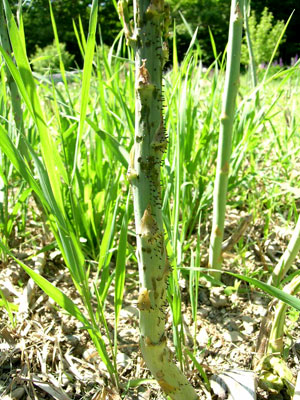 |
| Asparagus beetle eggs |
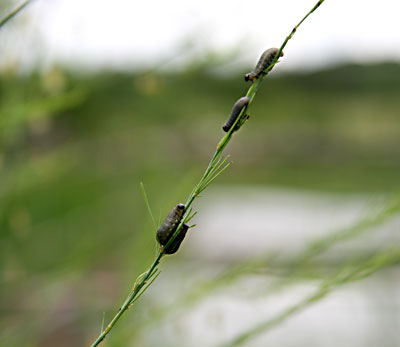 |
| Asparagus beetle larvae |
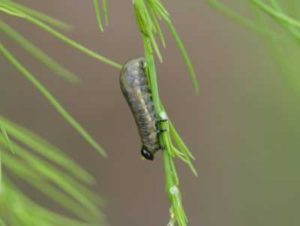  |
| Asparagus beetle larva |
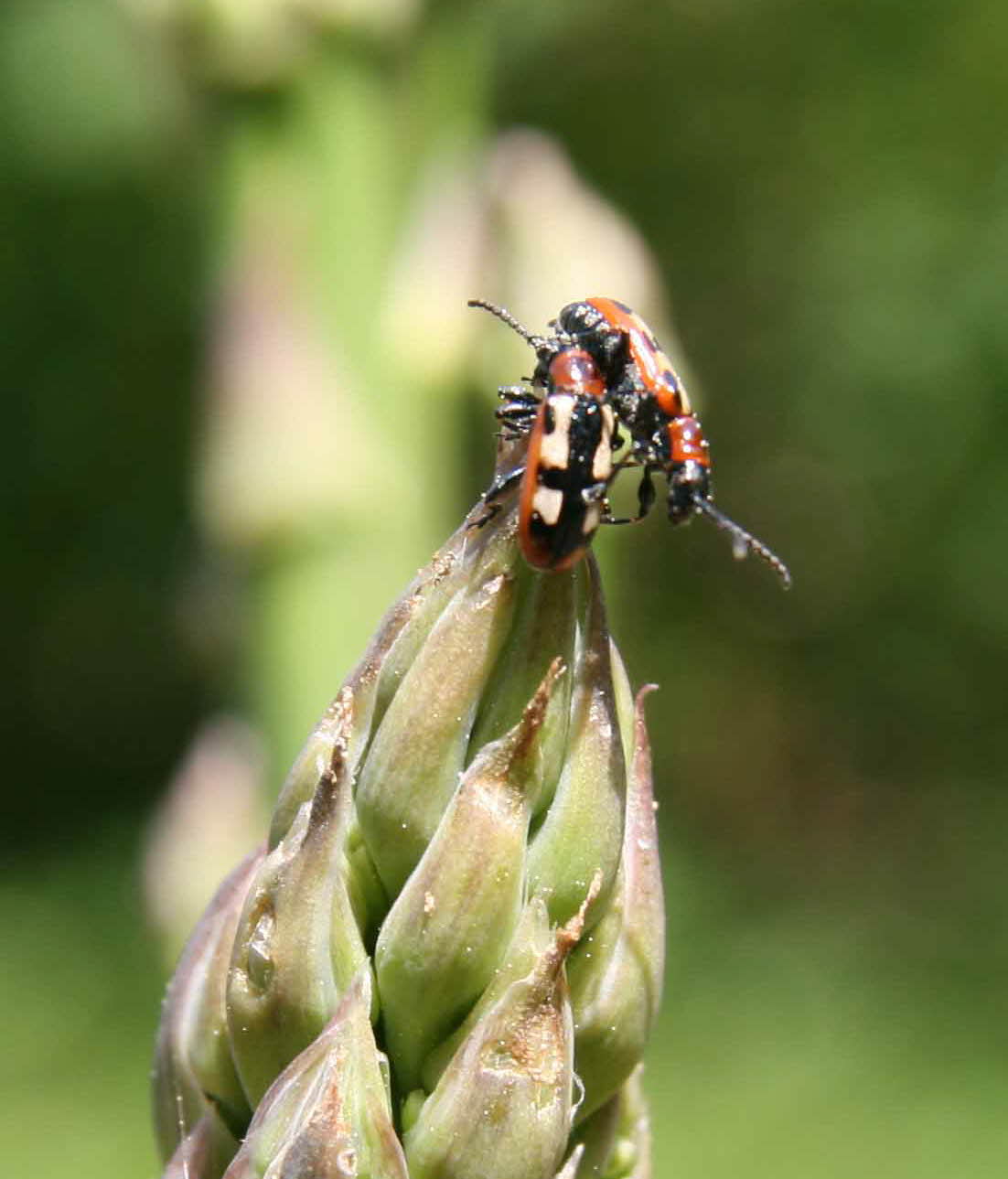 |
| Asparagus beetles |
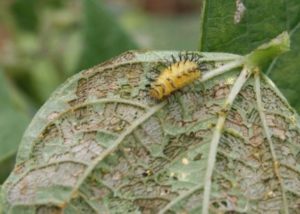  |
| Mexican Bean Beetle larva |
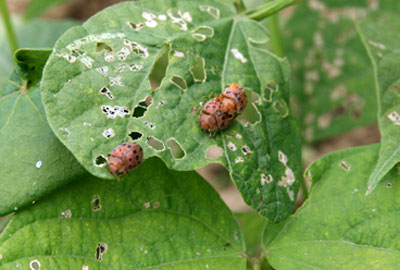 |
| Mexican bean beetles |
ASPARAGUS BEETLE, COMMON AND SPOTTED
Frost first
One of the very first questions I received when I began working for MOFGA many, many years ago turned into an argument. Not a good start for my tenure, but I stuck it out. The guy who called would not believe me that asparagus is frost sensitive. His spears had turned dark, wrinkled and water-soaked. I don’t know if I ever convinced him that the problem was they were frosted. Perhaps he is reading this.
Asparagus, despite its status as a primo early season vegetable, is highly sensitive to frost, ranking alongside cucumber, snap beans, eggplant and tomatoes in the ‘most susceptible’ category. There is still a good chance of frost.
When frosted, spears appear slightly darker green, water-soaked and break off easily. Thawed spears become mushy. Soft-rotting bacteria can enter the damaged tissue. New spears take several more days to emerge, but will. Temperatures below 33 degrees Fahrenheit may damage the spears.
The beetles
I have seen both kinds of asparagus beetles here already. Usually the spotted asparagus beetle becomes active somewhat later in the spring, and in my experience is less common (I guess with the names that is not a surprise). These two beetles are closely related and have similar life cycles, but it is the common asparagus beetle that is most damaging to the spears.
Common asparagus beetle (Crioceris asparigi) is blue-black, shiny, smooth and about 6 to 9 mm (1/4 inch) long, with three large yellow, squarish spots with red margins along each wing cover. Eggs are black, laid standing on end in rows along the spears, and hatch in 3-8 days. Larvae are wrinkled, plump, hump-backed, and dull gray with black head and legs. Some people call them “worms”. They grow up to 1/3 inch. These larvae feed in spears and in ferns. The larvae do the most damage, and eggs and larval damage makes spears unmarketable. Larval feeding can cause severe defoliation and weaken the stand. When full grown, larvae drop to the soil and pupate underground. New adults emerge in July, feed in ferns, and by September are looking for overwintering sites. Both species spend the winter as adult beetles either in field borders or within the asparagus field. Sheltered sites such as under bark or in the stems of old plants are preferred. Some burrow into the soil.
Spotted asparagus beetle (Crioceris duodecimpunctata) is reddish orange or tan, with six black spots on each wing cover (hence its other name, 12-spotted asparagus beetle). Eggs are greenish, glued singly on their sides to leaves. Eggs are laid on fronds, not on spears. Larvae are similar to those described above, but are orange colored, and feed almost entirely inside the berries so they affect seed production but do not hurt the plants.
Cultural controls: During harvest, you can greatly reduce the population by harvesting ALL of the ready spears every harvest. Do not allow any spears to develop into fronds until you are all done harvesting for the season. This reduces the number of stems where eggs will survive, and larvae can feed and grow up into the summer-generation beetles. In the fall remove all of the crop residue and other refuse nearby that provides shelter for adults over winter. Maintaining a clean environment in the fall will force beetles to seek shelter outside the field or burrow in the soil, where many predators reside.
Biocontrol: The most important natural enemy of Common asparagus beetle is a tiny parasitic wasp (Tetrastichus asparagi) that attacks the egg stage. Wasps kill eggs by feeding on them (sucking them dry), and also lay their own eggs inside the beetle eggs. The immature wasps grow inside the beetle larvae, killing them when they pupate. Studies have found >50% of eggs killed by feeding and half of the surviving larvae parasitized. Providing a nearby nectar source such as umbelliferous flowers may enhance wasp populations.
Monitoring and chemical control: Scout fields regularly. You may want to treat spears if >10% of the plants are infested with beetles or 2% have eggs or damage. The daily harvest makes treatment difficult because few want to spray anything close to harvest time. Treating infested fronds is important. Organic options include Entrust. Surround WP may work as a repellent.
Thanks to: Ruth Hazzard (U. Mass Vegetable Notes & The New England Vegetable Management Guide), and Brian Caldwell, Cornell University
MEXICAN BEAN BEETLE
Plan Ahead for Biological Control
(Reprinted and modified from Mass. Veg. Notes, written by Ruth Hazzard and A. Brown)
If Mexican bean beetles have historically been a problem on your farm, you will very likely see them again this year. They may be pests on snap beans, soybeans, and lima beans.
While they are not a pest on every farm, some farms report repeated significant damage from these pests and have to take action to prevent crop loss. Using biological control can reduce the need for insecticides.
Mexican bean beetle (MBB) adults are coppery brown with black spots. They look very much like large ladybeetles and in fact are closely related – but unlike lady beetles they feed on leaves, not other insects. Adults lay yellow-orange egg masses on the underside of bean leaves. These hatch into bright yellow, spiny oval larvae, which feed, molt several times as they grow, and pupate on the underside of leaves. Feeding damage from adults and larvae can reduce yield and injure pods if numbers are high. There are several generations per season, often with increasing populations in each generation.
Pediobius foveolatus is a commercially available biological control agent for Mexican bean beetle control and has a good track record in the mid-Atlantic states and among New England growers who have tried it. (Pediobius is pronounced “pee-dee-OH-bee-us”). It is mass-reared and sold by the New Jersey Dept of Agriculture and is also available from other beneficial insect suppliers. This small (1-3 mm), non-stinging parasitic wasp lays its eggs in Mexican bean beetle larvae. Wasp larvae feed inside the MBB larva, kill it, and pupate inside it, forming a brownish case or ‘mummy’. About twenty five adult wasps emerge from one mummy. Control continues and in fact gets better as the season progresses and successive generations of the wasp emerge and search out new bean beetle larvae.
Planning 2-3 releases at 7-10 day intervals will help ensure good timing. and coverage on several plantings. This makes it well suited to our succession-planted snap bean crops. After a release in the first plants, it is advisable to leave that planting intact for a while, until the new generation of wasps has emerged from their mummies. As with any biological control, make releases as soon as the pest is present – not after it has built up to damaging numbers. The New Jersey Dept. of Agriculture Beneficial Insect Rearing Laboratory recommends two releases, two weeks in a row, coinciding with the beginning of Mexican bean beetle egg hatch. Wasps will lay their eggs in larvae of any size, but it is best to target the newly-hatched young MBB larvae. This will give control before damage has been done. Thus, timing is important. Watch for eggs and time the shipment for the first hatch of eggs into larvae. If in doubt about the timing of the hatch, release as soon as you see the eggs – if you wait for the larvae you may be playing catch-up. The release rate should be at least 2000 adult wasps per field for less than an acre, or 3,000 per acre for fields of one acre or more.
The 2009 cost from NJDA is $40 plus shipping for 1000 adults, or $20 for 20 mummies (pupal parasites inside dead MBB larvae) from which about 500 adults will emerge. Order adults if you already have MBB larvae in the field. Ship for overnight delivery. Instructions for handling and release will come with the wasps. Wasps reproduce in the field and will still be around when the second generation of MBB hatches out. Thus, it should not be necessary to make more than two releases. Like beans, Pediobius wasps are killed by frost.
Plan ahead by contacting a supplier to inform them of your expected release dates and acreage. Contact information for New Jersey source: Tom Dorsey, 609-530-4192; address; NJDA, Phillip Alampi Insect Lab, State Police Drive, W. Trenton, NJ 08628. https://nj.gov/agriculture/divisions/pi/prog/beneficialinsect.html. You’ll also get advice on how to use the wasps from this office. Pediobius is also available from the following suppliers: IPM Laboratories, NY 315-497-2063, www.ipmlabs.com/; ARBICO, 800 -827-2847 (AZ), www.arbico.com/; Network (TN), 615-370-4301, www.biconet.com/.
If you would like assistance in using these biocontrols in your bean crops please call the UMass Extension Vegetable Program at 413-577-3976 or 413-545-3696 or email at [email protected]
Materials Approved for Organic Production
Moderate control can be achieved with Entrust as well as mixtures of pyrethrin (Pyganic EC5.0) and Neemix.
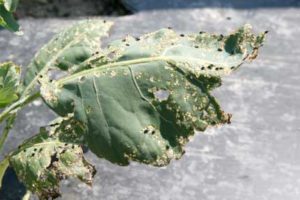  |
| Crucifer flea beetle damage |
FLEA BEETLES IN BRASSICAS
Flea beetles are busy feeding in spring plantings of brassica crops. Numbers are likely to rise in coming weeks as beetles move out of field borders where they spent the winter. Crucifer and striped flea beetles feed on Brassica crops as well as weeds that are in the same family, such as yellow rocket or wild mustard. [It is a different species of flea beetles that feeds on the tomato family of crops. This is important information when planning rotations of potatoes or tomatoes with Brassica crops or cover crops].
The crucifer flea beetle (Phyllotreta cruciferae) is uniformly black and shiny, about 2 mm in length, while the striped flea beetle (Phyllotreta striolata) has two yellow stripes on its back. Flea beetle adults feed on leaves and stems, resulting in numerous small holes, or ‘shot-holes’. Eggs are laid in the soil starting in late May, and beetle larvae feed on roots. The non-waxy greens (arugula, bok choi, tatsoi, mustard, Chinese cabbage, komatsuna) are preferred to the waxy cabbage, kale and collard types of brassicas. In brassica greens, beetles feed on the whole surface of the leaf, and will continue feeding from the seedling stage until harvest. Waxy crops are most susceptible at the cotyledon and seedling stage and feeding is more limited to leaf margins on older plants. Some crops simply out grow the beetle pressure and the damage can be tolerated. No damage can be tolerated in crops such as arugula.
To reduce and delay flea beetle invasion of spring crops, move them as far away as possible from the fields that were used for Brassica crops last fall. Beetles overwinter in field borders near last year’s crop. Planting the same crop close by to where it was last year ensures a high population in the spring. The same could be true if you have fields full of mustard weeds.
One of the best ways to protect Brassica crops from flea beetles is to place a floating row cover over the bed or row. It is critical to seal the edges immediately after seeding or transplanting, because Brassica seeds germinate quickly and beetles rapidly find the cotyledons. Flea beetles can fit through extremely tiny cracks. Edges of the cover must be sealed on all sides using soil, plastic bags filled with soil, or some other method.
Spinosad (Entrust is organic formulation) is proving to be effective in suppressing flea beetles and reducing damage. Pyrethrin (Pyganic EC 5) showed poor to moderate efficacy in trials, and has a short residual period. Yet some growers have reported a good knockdown with this product. You can spray right through the floating row covers and knock down any flea beetles that may have gotten inside.
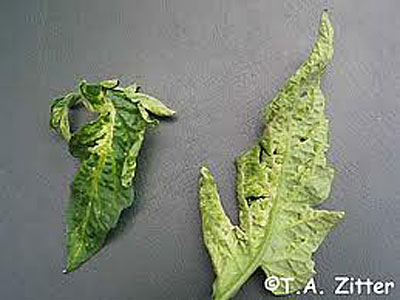 |
| Oedema develops when a plant absorbs water faster than it can be lost from the leaf surface. |
OEDEMA (EDEMA)
I often get calls this time of year from folks who fear they have a disease on their tomatoes, or related crops such as tomatillo. It is also a common problem in plants in the cabbage family, and some house plants. They see blisters or bumps on the surface of the leaves, most often the underside. The swellings initially appear pale-green, but they can erupt and turn yellow, brown or even black. Eventually, corky spots appear on the underside of the leaves. Older leaves are more often affected than younger leaves.
Oedema is not a disease caused by a pathogen, but rather is a physiological disorder that develops when a plant absorbs water faster than it can be lost from the leaf surface. Excess moisture builds and the blisters form. This is most commonly induced when transpiration is limited. Transpiration (the natural loss of water from the plant) is reduced by cloudy days, humid conditions in a greenhouse, cool temperatures, low light levels such as when plants are raised on a windowsill in a home, etc. Overwatering under these conditions is commonly the biggest factor causing the problem.
Leaves affected with edema never clear up, but there are steps to be taken to prevent more of the problem:
* Cut back on watering, but do not let the plants completely dry out.
* Water only in the morning
* Increase the light if it is low.
* Increase ventilation and avoid over-crowding plants
